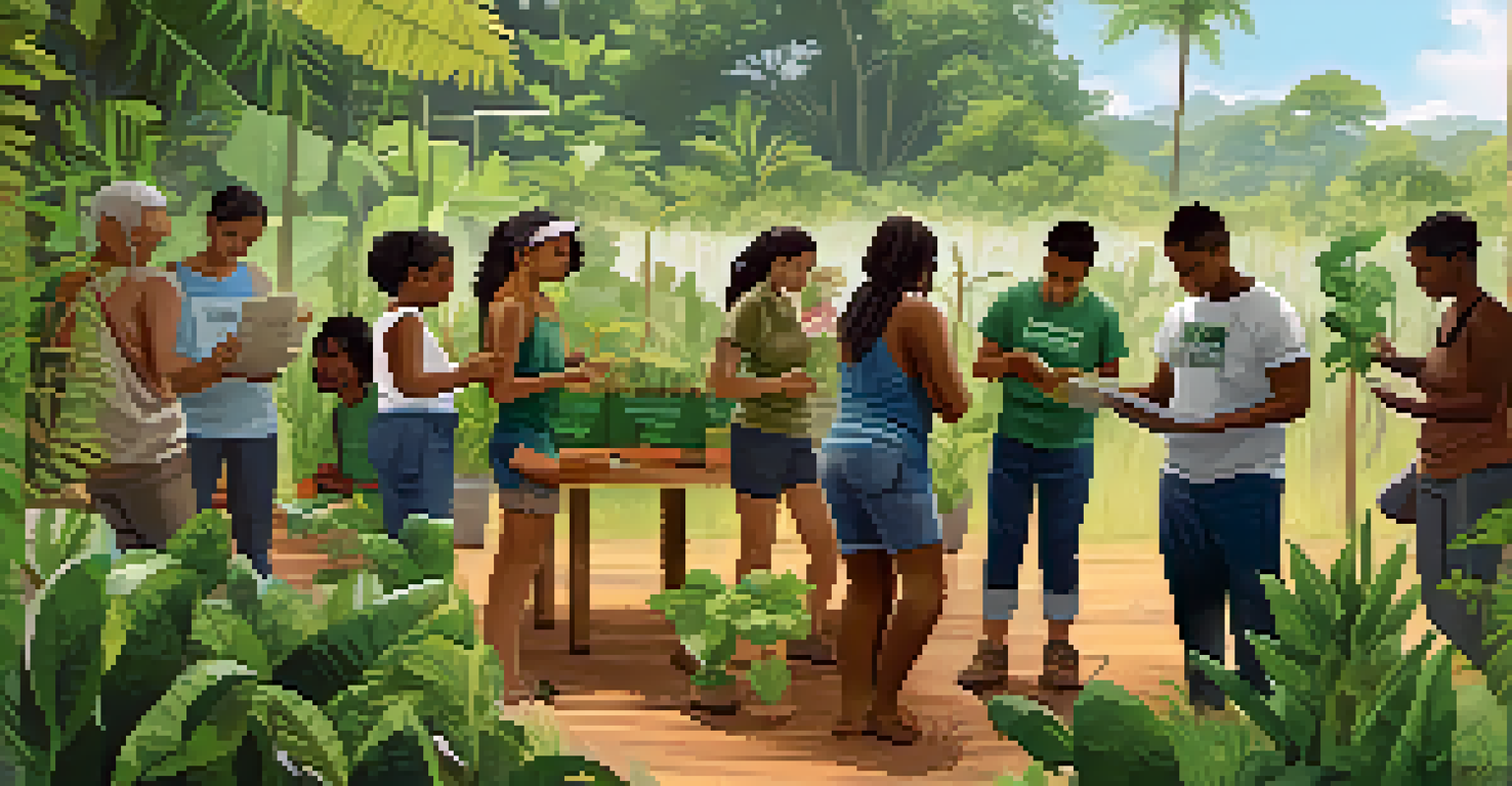Brazilian Flora Conservation: Protecting Unique Species

The Importance of Brazil's Unique Flora
Brazil is home to an astonishing variety of plant species, many of which are found nowhere else on Earth. This rich biodiversity is vital for maintaining ecosystems and supporting wildlife. Plants play a crucial role in regulating climate, preserving soil, and providing oxygen. Without these unique species, the entire ecological balance could be at risk.
The environment is where we all meet; where we all have a mutual stake; it is the only thing we all share.
The Amazon Rainforest, the Atlantic Forest, and the Cerrado are just a few of the regions that showcase Brazil's plant diversity. Each area hosts species that have adapted to specific environments, contributing to their uniqueness. For instance, the Brazil nut tree is not only iconic but also essential for the survival of various forest ecosystems. Protecting these plants means protecting the habitats they support.
Moreover, Brazilian flora holds immense cultural significance, impacting local communities and economies. Many indigenous groups rely on native plants for food, medicine, and traditional practices. The loss of these species would not only harm the environment but also erase cultural heritage.
Current Threats to Brazilian Flora
Brazil's flora faces numerous threats, primarily due to human activities. Deforestation for agriculture, logging, and urban development has drastically reduced forest areas, leading to habitat loss. This not only puts individual species at risk but also disrupts entire ecosystems. For instance, the Atlantic Forest has been reduced to a fraction of its original size, severely affecting its unique plant life.

Climate change is another significant threat, impacting rainfall patterns and temperatures. These changes can alter the delicate balance of ecosystems, making it difficult for certain plant species to survive. Additionally, invasive species introduced by human activity can outcompete native plants, further endangering them.
Brazil's Flora is Ecologically Vital
The unique plant species in Brazil are crucial for maintaining ecosystems, regulating climate, and supporting wildlife.
Pollution also plays a role in threatening Brazilian flora. Contaminated water sources and soil can harm plant health and reduce biodiversity. The combined effects of these threats create a challenging environment for conservation efforts, necessitating immediate action.
Conservation Efforts Underway in Brazil
In recent years, Brazil has made significant strides in conservation efforts aimed at protecting its flora. Government initiatives, alongside NGOs, have been established to promote sustainable practices and restore degraded areas. For instance, reforestation projects have gained momentum, aiming to revive ecosystems and support biodiversity. These efforts not only help plants but also benefit the wildlife that depends on them.
In every walk with nature, one receives far more than he seeks.
Protected areas, such as national parks and reserves, have been created to safeguard crucial habitats. These areas serve as sanctuaries for many endangered species, allowing ecosystems to recover. Additionally, the Brazilian government has implemented laws to regulate land use and protect threatened plants from exploitation.
Community involvement is also a key component of successful conservation. Local populations are encouraged to engage in sustainable practices and participate in conservation projects. By fostering a sense of ownership and responsibility, these initiatives help ensure that conservation efforts are effective and long-lasting.
The Role of Education in Conservation
Education plays a pivotal role in promoting awareness about Brazil's unique flora. Through educational programs, communities learn about the importance of biodiversity and the need for conservation. Schools often incorporate environmental education, encouraging the younger generation to appreciate and protect their natural heritage. This knowledge empowers individuals to make informed decisions that positively impact the environment.
Workshops and seminars conducted by conservation organizations further enhance understanding of ecological issues. These events provide practical skills for sustainable practices, such as gardening with native plants. By fostering a sense of stewardship, educational initiatives help cultivate a community that values and protects its flora.
Human Activity Threatens Biodiversity
Deforestation, climate change, and pollution significantly endanger Brazil's diverse flora and disrupt entire ecosystems.
Moreover, digital platforms and social media serve as powerful tools for outreach. They enable broader access to information about conservation efforts and the struggles faced by Brazil's flora. Engaging storytelling can inspire people across the globe to advocate for plant conservation, fostering a collective responsibility.
Engaging Local Communities in Conservation
Local communities are at the heart of effective conservation efforts in Brazil. Their traditional knowledge about the land and its resources can guide sustainable practices. By involving these communities in conservation initiatives, we can ensure that efforts are culturally relevant and effective. This collaboration often leads to better outcomes for both people and the environment.
Community-led projects, such as sustainable agriculture and eco-tourism, provide alternative livelihoods while protecting flora. For example, farmers can adopt agroforestry techniques that integrate native plants into their agricultural practices. This not only conserves biodiversity but also enhances soil health and crop yields.
Moreover, celebrating local flora through festivals and cultural events can strengthen community ties and promote conservation. By highlighting the importance of native plants in local traditions, communities are more likely to appreciate and protect their unique flora.
Challenges in Brazilian Flora Conservation
Despite the ongoing efforts, Brazilian flora conservation faces several challenges. Funding for conservation projects can be limited, making it difficult to implement large-scale initiatives. Additionally, political instability and changing priorities can hinder progress, as policies may shift with changing administrations. These factors create an uncertain environment for long-term conservation strategies.
Another challenge is the need for comprehensive research on plant species and ecosystems. Many species remain understudied, which complicates conservation planning. Understanding their ecological roles and responses to threats is crucial for developing effective strategies. Without this knowledge, efforts may be misdirected or insufficient.
Collaboration is Key for Conservation
Effective conservation of Brazilian flora relies on the cooperation of governments, NGOs, and local communities to implement sustainable practices.
Finally, public awareness and support for conservation initiatives can fluctuate. Engaging the broader population in ongoing dialogues about the importance of flora conservation is essential. Sustained advocacy can help maintain momentum and ensure that conservation remains a priority.
The Future of Brazilian Flora Conservation
The future of Brazilian flora conservation relies on collaboration between various stakeholders. By uniting governments, NGOs, and local communities, we can create a more robust conservation framework. This collaborative approach can leverage resources, expertise, and local knowledge to achieve meaningful outcomes. Together, we can develop innovative solutions to protect Brazil's unique plant life.
Advancements in technology can also play a significant role in conservation efforts. Tools such as remote sensing and genetic analysis can enhance our understanding of ecosystems and improve monitoring efforts. These technologies can help track changes in biodiversity and inform adaptive management strategies, ensuring that conservation measures remain effective over time.

Ultimately, fostering a culture of conservation is essential for the future. Encouraging individuals to value and protect their natural heritage will lead to more sustainable practices. As we work together to safeguard Brazil's unique flora, we can inspire future generations to cherish and preserve the planet's biodiversity.